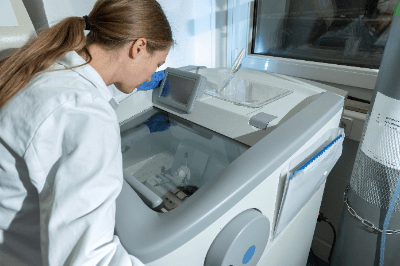What Is a Cryostat?

A cryostat is a device designed to achieve and maintain cryogenic temperatures, essential for preserving samples at low temperatures during research and development activities. It operates using refrigerants like liquid helium or nitrogen, Peltier elements, or refrigeration coolers. It maintains temperatures by enclosing the sample within a vacuum vessel inside a temperature-controlled chamber or directly applying refrigerant via a thin nozzle.
Used independently or as part of cryo-electron microscopes, semiconductor measurement devices, and superconducting applications, cryostats are crucial in spectroscopic analysis and other high-precision scientific endeavors.
Uses of Cryostats
Cryostats create stable low-temperature environments for various scientific measurements, including UV/Visible/IR absorption spectroscopy, fluorescence spectroscopy, circular dichroism spectroscopy, electrical and AC susceptibility measurements, and Hall effect measurements. They are invaluable in suppressing thermal vibrations and preventing thermodynamic damage to sensitive samples, with applications extending to microscopy and electrical connectivity for a range of devices.
Principle of Cryostats
1. Cooling Mechanism
Cryostats employ liquid nitrogen or helium, Peltier elements, and refrigeration methods to cool samples. Their design allows for precise temperature control essential for cryogenic research.
2. System Configuration
There are two main cryostat configurations: sealed systems that use a vacuum vessel for insulation and open systems that cool samples directly with refrigerant spray. Sealed systems offer deeper cryogenic temperatures and complex sample management, whereas open systems provide ease of use and direct observation capabilities at slightly higher minimum temperatures.
3. Optical Window
Cryostats feature optical windows to observe and analyze samples without compromising the low-temperature environment, facilitating spectroscopic studies.
Types of Cryostats
Varieties of cryostats cater to specific research needs, from cryogen-free models that reduce the necessity for liquid refrigerants to those integrated with superconducting magnets for advanced scientific applications. The choice of cryostat depends on the minimum temperature requirements, optical window needs, and whether electrical contact with the sample is required.
Other Information on Cryostats
Equipment With a Built-in Cryostat
Beyond standalone use, cryostats are integral to numerous scientific instruments, including cryo-electron microscopes, medical MRI machines, semiconductor testers, cryogenic optical measurement devices, astronomical sensors, nuclear fusion reactors, and protein crystallography devices.